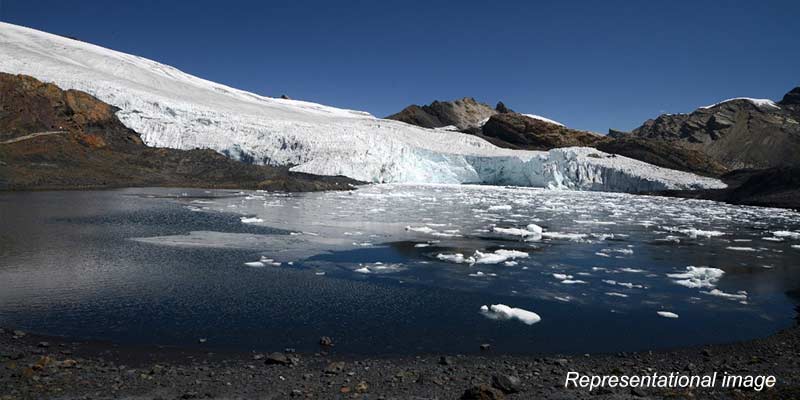- World
- Mar 21
Many glaciers will not survive this century, warn climate scientists
• For the first time, the UN observes World Day for Glaciers on March 21.
• In December 2022, the UN General Assembly adopted the resolution to declare 2025 as the ‘International Year of Glaciers’ Preservation, accompanied by the proclamation of March 21 of each year as the World Day for Glaciers starting in 2025.
• The International Year and World Day for Glaciers aim to raise global awareness about the critical role of glaciers, snow and ice in the climate system and the hydrological cycle, and the economic, social and environmental impacts of the impending changes in the Earth’s cryosphere, as well as to share best practices and knowledge in this regard and in addressing issues related to accelerated melting of glaciers and its consequences.
• Glaciers in many regions will not survive the 21st century if they keep melting at the current rate, potentially jeopardising hundreds of millions of people living downstream, according to reports from the World Meteorological Organisation (WMO) and the World Glacier Monitoring Service (WGMS).
• The first ever World Day for Glaciers sounds the alarm that accelerating glacier melt risks unleashing an avalanche of cascading impacts on economies, ecosystems and communities, not just in mountain regions but at global level.
• Five of the past six years have witnessed the most rapid glacier retreat on record. 2022-2024 witnessed the largest three-year loss of glacier mass on record.
The dynamics of glaciers
• Glaciers are bodies of moving ice that develop as snow accumulated in cold places compacts and recrystallizes. The formation of a glacier takes decades to millennia, and its size varies depending on the amount of ice it retains throughout its lifespan.
• Each year, glaciers gain and lose mass. They gain mass from snow and precipitation in their upper portions (accumulation zone) and lose mass in their lower portions (ablation zone) by partially melting in summer. In marine-terminating glaciers, they also lose mass by calving icebergs that float away.
• The balance between accumulation and ablation is the mass balance of the glacier. If accumulation is greater than ablation, then the glacier has a positive mass balance and will advance. If ablation is greater than accumulation, then the glacier has a negative mass balance and will retreat.
• The glacier terminus is the end of a glacier at any given point in time. Changes in the terminus position are often used as an important indicator for monitoring the long-term dynamic behavior of glaciers.
• Earth’s glaciers vary incredibly in their sizes and shapes, ranging from small cirque glaciers to ice masses hundreds of meters thick in mountains and ice sheets.
There are two main groups of glaciers:
i) Unconstrained glaciers have a morphology and flow pattern largely independent of underlying topography, like polar ice caps or the Antarctic and Greenland ice sheets.
ii) Constrained glaciers have a morphology and flow pattern strongly dependent on underlying topography, like ice field, cirque, valley, piedmont and tidewater glaciers.
• More than 275,000 glaciers worldwide cover approximately 700,000 sq km.
• Together with ice sheets, glaciers store about 70 per cent of the global freshwater resources.
• High mountain regions are the world’s water towers.
• Depletion of glaciers therefore threatens supplies to hundreds of millions of people who live downstream and depend on the release of water stored over past winters during the hottest and driest parts of the year.
Glacier preservation is an environmental and economic necessity
• Based on a compilation of worldwide observations, the World Glacier Monitoring Service estimates that glaciers (separate from the continental ice sheets in Greenland and Antarctica) have lost a total of more than 9,000 billion tonnes since records began in 1975.
• This is equivalent to a huge ice block of the size of Germany with a thickness of 25 meters.
• In 2024, glaciers in Scandinavia, the Norwegian archipelago of Svalbard and North Asia experienced the largest annual loss of overall mass on record.
• Glaciologists determine the state of a glacier by measuring how much snow falls on it and how much melt occurs every year, according to UN partner the World Glacier Monitoring Service (WGMS) at the University of Zurich.
• The melting of glaciers affects everyone: people living in coastal areas affected by sea level rise, people living in high mountain areas more prone to the risks of flooding, landslides and avalanches, and people living in downstream areas that are dependent on water supply from glaciers.
• Melting glaciers and ice sheets were identified as one of the largest contributors of sea level rise in the past decades.
• In the short-term, glacier melt increases natural hazards like floods.
• At present melt rates, many glaciers in Western Canada and the USA, Scandinavia, Central Europe, the Caucasus, New Zealand, and the Tropics will not survive the 21st century.
• In the 500-mile-long Hindu Kush mountain range, located in the western Himalayas and stretching from Afghanistan to Pakistan, the livelihoods of more than 120 million farmers are under threat from glacial loss.
The mountain range has been dubbed the “third pole” because of the extraordinary water resources it holds.
Manorama Yearbook app is now available on Google Play Store and iOS App Store


